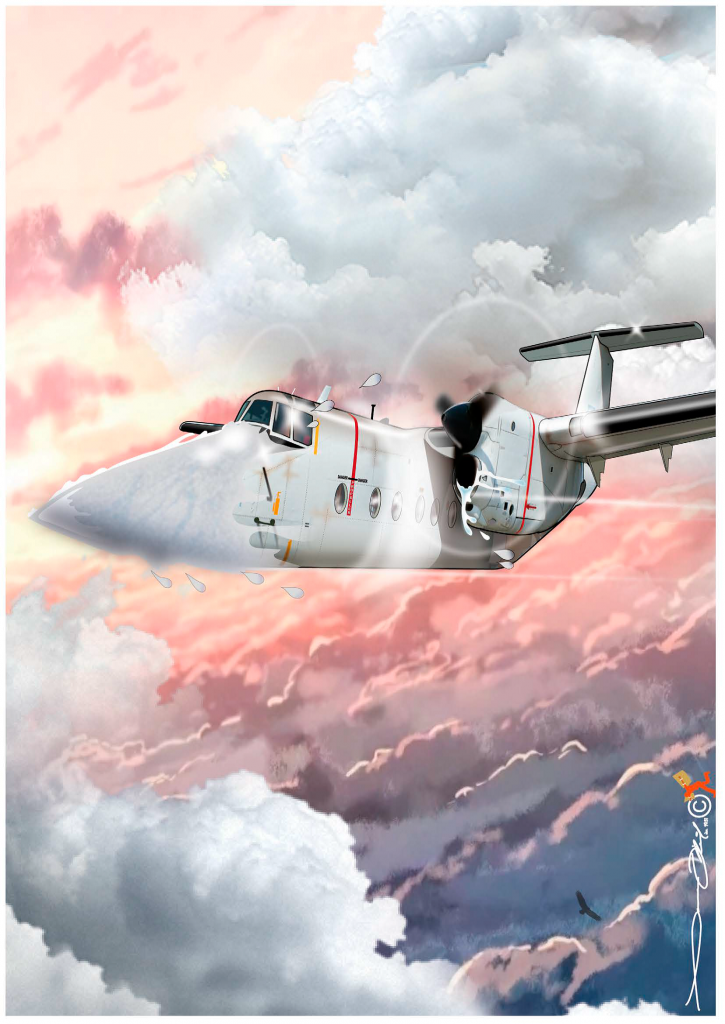The DHC-5D Buffalo is a medium-weight, fixed-wing, two engined tactical transport aircraft. It can carry forty fully equipped paratroopers or a couple of 4x4s in the cabin and it can chuck them out of the back all in one go.

THE BUFFALO HAS QUITE extraordinarily short takeoff and landing capability for such a large aircraft.
On the ground, it looks ungainly and uncomfortable with its stalky undercarriage and the angular sweep of the back end up to the impossibly high ‘T’ tail. Then there are its bulldog features, set off by the large, black, round snout…surely only its mother could love it?
So that’s the Buffalo for you…or is it?
Start the auxiliary power unit and power up the electrics and hydraulics and you are ready to fire up the big boys and find out. As the whistle of the turbines increases in volume and pitch, the great blades of the enormous propeller begin to turn like the sails of some massive metallic windmill. Slowly the prop gathers speed until the blades become a blur and the engine settles down into a comfortable snuffling rhythm, which gives no hint of what is to follow.
Final pre-take off checks completed, the beast is lined up and as power is gently increased the snuffle becomes a low rumble and the aircraft begins to accelerate. The rumble increases to a growl and the airframe begins to quiver in sympathy.
‘the growl becomes a deep, full-throated roar’
All temperatures and pressures in the green, speed is building…go for maximum power. Now the growl becomes a deep, full-throated roar as the last three inches of each propeller blade break the sound barrier. The acceleration is spectacular, thrusting the flight crew back into their seats.
Coils of condensation stream back from the props as the aircraft surges forward and then suddenly the nose lifts into the air. The stalky, uncomfortable-looking waddler transforms itself into a powerful but strangely elegant flying machine with an unmistakable booming voice.
Concorde would appear to be absurd, but I was tempted to do just that some years ago during a Buffalo trip from the UK to Oman. I was flying with a very experienced old friend called John. He had flown Bristol Brigands with the Royal Air Force during the ‘Confrontation’ with Burma. He had been shot down and bailed-out and on his way out he collided with one of the tail fins during his evacuation. That cost him a kidney which gave him a Medical Discharge from the RAF.

We stopped at Larnaka in Cyprus for fuel and then took off for Bahrein. As we approached Beirut we encountered a giant curtain of solid cloud, topped out by an angry-looking roiling pelmet at about 25,000 feet above sea level.
I was only on my fourth UK trip in command and I turned to John and said, “Well, I don’t know about you, John, but if I was on my own, I would probably turn round and go back to Larnaka to wait until this lot goes somewhere else.”
“Mmmmm…” said John. “Let’s have a look at the radar.” He turned the range up to two hundred miles. “Mmmmm…” he said again, “Well there’s nothing on the radar, so why don’t we just stick our noses in there and have a quick look-see?”
So that’s what we did. I was hand flying the aircraft, in case there were some serious lumps up ahead. As we approached it became evident that the cloud was not actually cloud at all, it was snow…heavy, heavy snow.
As we flew along in flat calm air white moustaches of snow built up over the tops of the engine intakes. Every so often they fell into the hole. This would cause my eyes to jerk nervously to the engine instruments, but they just stayed rigidly glued to their normal parameters as though there was nothing which worried them about flying through thick, thick snow.

Then suddenly there was a rumbling thump as though we had bumped into something large and soft. My heart leapt into my mouth and I shot a nervous glance at John for reassurance.
“How about doing the ‘SADIE’ checks?” he said.
I nodded and worked my way through as I said them out loud; ‘Suction, Amps, DI to Compass, Icing, Engine temperatures and pressures in the green.’
I checked the outside air temperature gauge probe, to see how much ice had built up on it. The probe was mounted just forward of the central windscreen pillar and I had to lean forward in order to get a good look at it.
It was then that I became aware of something so unexpected that it took me some seconds to take it in. The Buffalo seemed to have grown an enormously long, pointed, white nose. It was as though the old girl had decided that she wanted to be Concorde for a while.
Then, as I watched, the Concorde nose disappeared – accompanied by that rumbling thump which had caught my attention just minutes before as the snow-snoot tumbled back down under the fuselage.
So yes – a Buffalo can indeed pretend to be a Concorde, even if it’s only for a short time, while flying in a snowstorm over Beirut!


